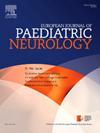Evolution of neuroimaging features in children with acute flaccid myelitis compared to other forms of childhood myelitis
IF 2.3
3区 医学
Q3 CLINICAL NEUROLOGY
引用次数: 0
Abstract
Background
Acute flaccid myelitis (AFM) is characterized by acute onset of flaccid limb weakness, MRI abnormalities in the spinal cord grey matter and CSF pleocytosis often associated with enterovirus infections. MOG-associated diseases (MOGAD) can manifest with similar neuroradilogical features.
Objective
To analyze MRI findings in patients with AFM at baseline and follow-up in comparison to other forms of childhood transverse myelitis such as MOGAD.
Patients and methods
Children from 11 European centers who fulfilled the clinical criteria of AFM were included. Brain and spinal MRI was performed at various stages of the disease course. MRI scans were evaluated using a previously established scoring table and compared with MRI scans of a recently published cohort of children with different forms of transverse myelitis including MOGAD.
Results
We included 15 patients (8 females, 7 males, age range: 9 months-9,11 years). In 10/15 patients enterovirus was detected in respiratory/rectal specimens. At first presentation 13/15 patients presented with a longitudinal extensive transverse myelitis like involvement. Cervical grey matter was involved in almost all children. Axial involvement either manifested as grey matter alone or a mixture of white matter and grey matter hyperintensity in T2. Nerve root enhancement was found in 2/15 and leptomeningeal enhancement in 1/15 patients. 5/15 children had brainstem lesions. Follow-up MRI revealed residual T2 hyperintensities in 7/11 patients. Compared to patients with MOGAD AFM patients showed equally good resolution of MRI lesions overtime.
Conclusion
Longitudinal spinal cord lesions mainly affecting the grey matter are characteristic of AFM whereas supratentorial lesions are less common. There is no significant difference between AFM and MOGAD concerning the resolution of lesions overtime.
与其他形式的儿童脊髓炎相比,急性弛缓性脊髓炎儿童神经影像学特征的演变。
背景:急性弛缓性脊髓炎(AFM)的特征是急性发作的弛缓性肢体无力,脊髓灰质MRI异常和脑脊液多细胞增多常与肠病毒感染有关。mog相关疾病(MOGAD)可以表现出类似的神经影像学特征。目的:分析AFM患者在基线和随访时的MRI表现,并与其他形式的儿童横贯脊髓炎(如MOGAD)进行比较。患者和方法:来自11个欧洲中心的符合AFM临床标准的儿童被纳入研究。在病程的各个阶段进行脑和脊柱MRI检查。MRI扫描使用先前建立的计分表进行评估,并与最近发表的不同形式横贯脊髓炎(包括MOGAD)儿童队列的MRI扫描进行比较。结果:我们纳入了15例患者,其中女性8例,男性7例,年龄范围:9个月,9岁,11岁。10/15例患者呼吸道/直肠标本检出肠道病毒。初次发病时,13/15的患者表现为纵向广泛的横向脊髓炎样受累。几乎所有儿童都涉及宫颈灰质。轴向受累表现为单独的灰质或在T2表现为白质和灰质高信号。2/15的患者有神经根增强,1/15的患者有轻脑膜增强。5/15患儿脑干病变。随访MRI显示7/11例患者残留T2高信号。与MOGAD患者相比,AFM患者表现出同样好的MRI病变消退。结论:主要影响灰质的脊髓纵向病变是AFM的特征,而幕上病变较少见。AFM和MOGAD在病变随时间消退方面无显著差异。
本文章由计算机程序翻译,如有差异,请以英文原文为准。
求助全文
约1分钟内获得全文
求助全文
来源期刊
CiteScore
6.30
自引率
3.20%
发文量
115
审稿时长
81 days
期刊介绍:
The European Journal of Paediatric Neurology is the Official Journal of the European Paediatric Neurology Society, successor to the long-established European Federation of Child Neurology Societies.
Under the guidance of a prestigious International editorial board, this multi-disciplinary journal publishes exciting clinical and experimental research in this rapidly expanding field. High quality papers written by leading experts encompass all the major diseases including epilepsy, movement disorders, neuromuscular disorders, neurodegenerative disorders and intellectual disability.
Other exciting highlights include articles on brain imaging and neonatal neurology, and the publication of regularly updated tables relating to the main groups of disorders.

 求助内容:
求助内容: 应助结果提醒方式:
应助结果提醒方式:


